川外2011年硕士研究生招生考试(初、复试)参考书目
- 格式:doc
- 大小:75.00 KB
- 文档页数:7
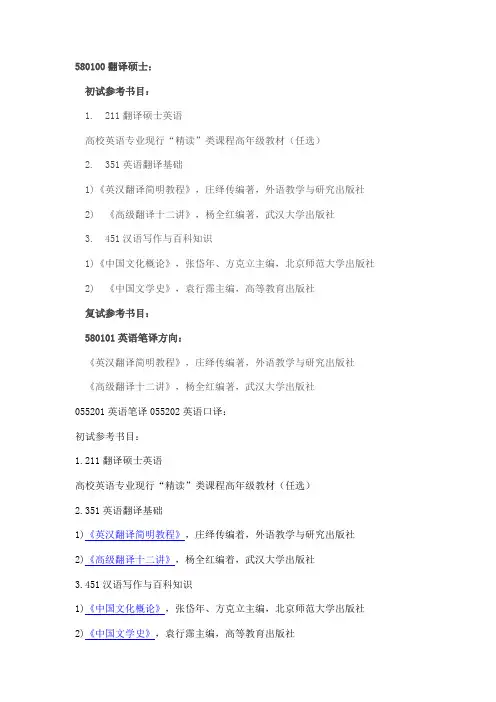
580100翻译硕士:
初试参考书目:
1. 211翻译硕士英语
高校英语专业现行“精读”类课程高年级教材(任选)
2. 351英语翻译基础
1)《英汉翻译简明教程》,庄绎传编著,外语教学与研究出版社
2) 《高级翻译十二讲》,杨全红编著,武汉大学出版社
3. 451汉语写作与百科知识
1)《中国文化概论》,张岱年、方克立主编,北京师范大学出版社
2) 《中国文学史》,袁行霈主编,高等教育出版社
复试参考书目:
580101英语笔译方向:
《英汉翻译简明教程》,庄绎传编著,外语教学与研究出版社《高级翻译十二讲》,杨全红编著,武汉大学出版社
055201英语笔译055202英语口译:
初试参考书目:
1.211翻译硕士英语
高校英语专业现行“精读”类课程高年级教材(任选)
2.351英语翻译基础
1)《英汉翻译简明教程》,庄绎传编着,外语教学与研究出版社
2)《高级翻译十二讲》,杨全红编着,武汉大学出版社
3.451汉语写作与百科知识
1)《中国文化概论》,张岱年、方克立主编,北京师范大学出版社
2)《中国文学史》,袁行霈主编,高等教育出版社
复试参考书目:
055201英语笔译:
《英汉翻译简明教程》,庄绎传编着,外语教学与研究出版社
《高级翻译十二讲》,杨全红编着,武汉大学出版社
055202英语口译:
《实用口译教程新编——理论技巧与实践》,李芳琴等编着,四川人民出版社。

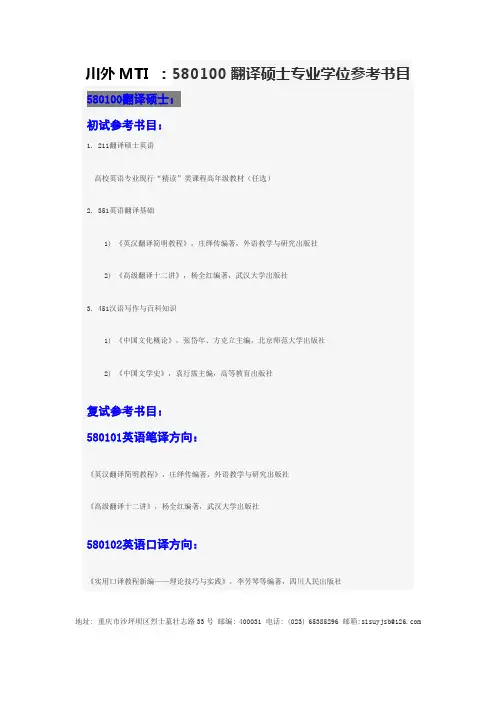
川外MTI :580100翻译硕士专业学位参考书目580100翻译硕士:
初试参考书目:
1. 211翻译硕士英语
高校英语专业现行“精读”类课程高年级教材(任选)
2. 351英语翻译基础
1) 《英汉翻译简明教程》,庄绎传编著,外语教学与研究出版社
2) 《高级翻译十二讲》,杨全红编著,武汉大学出版社
3. 451汉语写作与百科知识
1) 《中国文化概论》,张岱年、方克立主编,北京师范大学出版社
2) 《中国文学史》,袁行霈主编,高等教育出版社
复试参考书目:
580101英语笔译方向:
《英汉翻译简明教程》,庄绎传编著,外语教学与研究出版社
《高级翻译十二讲》,杨全红编著,武汉大学出版社
580102英语口译方向:
《实用口译教程新编——理论技巧与实践》,李芳琴等编著,四川人民出版社
地址: 重庆市沙坪坝区烈士墓壮志路33号邮编: 400031 电话: (023) 65385296 邮箱:sisuyjsb@。
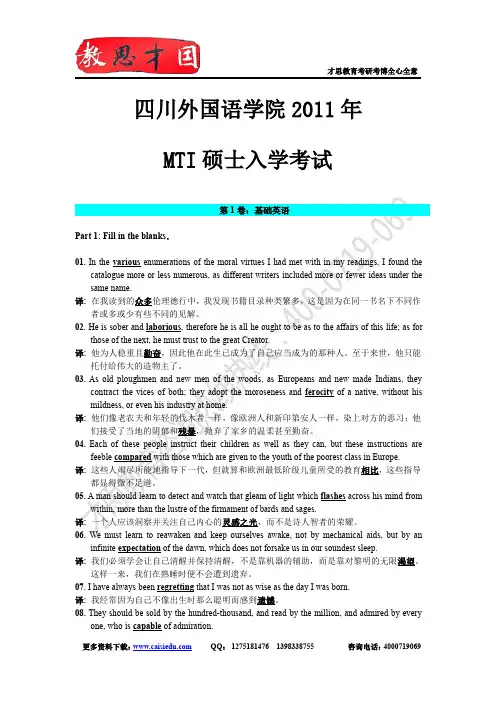
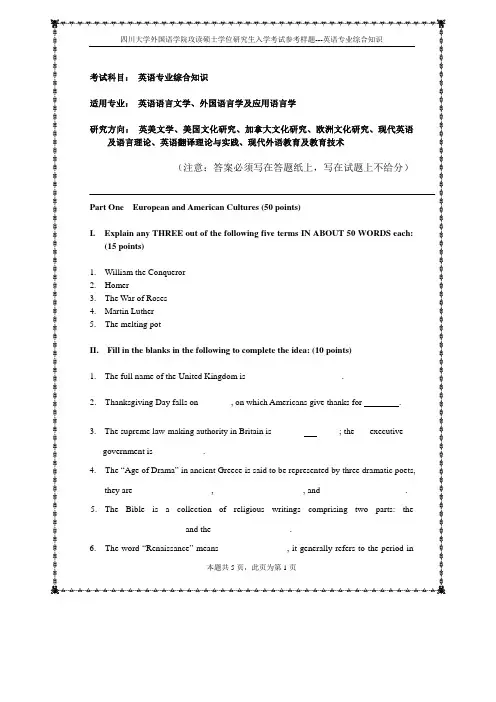
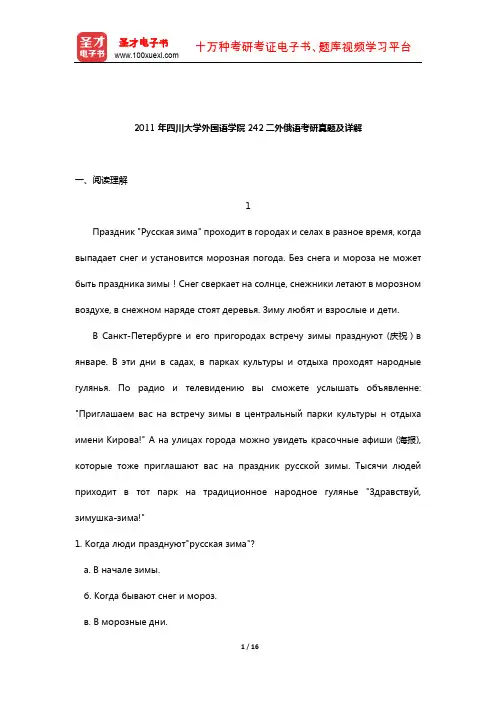
2011年四川大学外国语学院242二外俄语考研真题及详解一、阅读理解1Праздник "Русская зима" проходит вгородах и селахв разноевремя, когдавыпадаетснег и установится морозная погода. Без снега и морозане может быть праздника зимы!Снег сверкает насолнце, снежники летают в морозномвоздухе, в снежном нарядестоят деревья. Зиму любят и взрослыеидети.В Санкт-Петербургеиегопригородах встречу зимыпразднуют (庆祝)в январе. В эти днивсадах, впаркахкультурыи отдыха проходят народные гулянья. По радио и телевидению вы сможете услышать объявленне: "Приглашаем васна встречу зимы в центральный парки культурын отдыха имени Кирова!" А на улицах города можно увидеть красочные афиши (海报), которые тоже приглашают вас на праздник русской зимы. Тысячи людей приходит втот парк на традиционное народное гулянье "Здравствуй, зимушка-зима!"1. Когда люди празднуют"русская зима"?а. В начале зимы.б. Когда бывают снег и мороз.в. В морозные дни.2. Где празднуют встречу зимы в Санкт-Петербурге?а. Около площади Зимнего дворца.б. В доме культуры.в. В парке и на улицах.【答案与解析】1.б问题是:人们什么时候庆祝“俄罗斯的冬天”?由第一段第一句可知,当下雪并且天气彻底寒冷下来时人们庆祝节日“俄罗斯的冬天”。
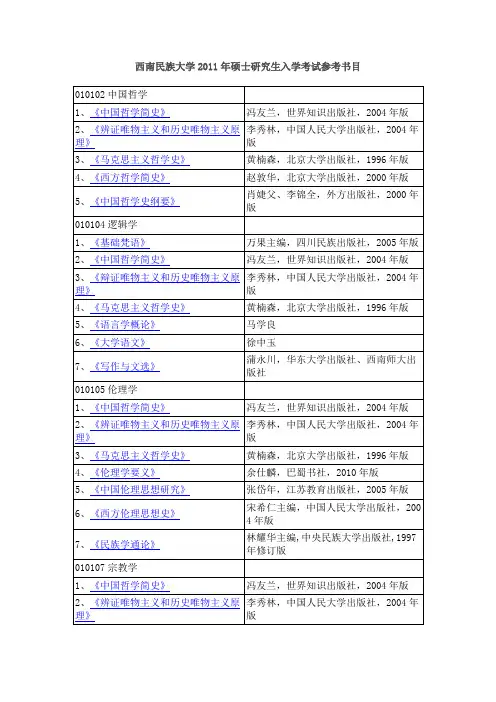

四川外语学院2011年二外英语考研真题I. Beneath each of the following sentences, there are four choices marked A, B, Cand DChoose the one that best completes the sentence. Write your answers on the ANSWER SHEET. (15%)1. Charles Babbage is generally considered _________the first computers.A. to inventB. inventing C to have invented D. having invented2. ________was once regarded as impossible has now become a reality.A. What B. That C. Which D. As3. _______from the top of the hill, the lake scenery is beyond description.A. To see B. Seeing C. Seen D. Having4. Three days later word came ________our country had sent up another man-made satellite.A. when B. which C. that D. where5. The reason ________he gi ves for being absent from today‟s meeting is unacceptable.A which B. for which C. in which D. why6. If you need further information, please_______ our office.A. constant B. construct C. contact D. contain7. But for the rain, we ________a nice holiday.A. should have B. would have had C. would have D. will have had8. It was not until mid-night ________their way out of the forest.A. when they found B. that they foundc. did they find D. that they didn‟t find9. John complained to the bookseller that there were several pages________ in the dictionary.A. missing B. losing C. dropping D. leaking10. ________you were busy, I wouldn‟t have bothered you with my questions.AIf I realized B. Had I realizedC. Did I have realized that D. As I realized11. _________, he felt tired out after the eight-hour long journey.A. Strong as he is B. The stronger he isC. Strong man that he is D. For he is strong12. We‟ll have to finish the job, _________.A. long it takes however B. it takes however longC. long however it takes D. however long it takes13. Is this museum _________some of your friends visited last month?Athat B. where Cin which D. the one14. She fai led to call the doctor‟s assistant to ________her appointment.A. greet B. miss Cruin D. cancel15. I decided to stop and have a drink, _________I was feeling quite thirsty.A. for B. moreover Cconsequently D. whereas.II. Each of the following sentences contains one mistake. Among the four choices marked A, B, Cand D, choose the one in which you think the mistake is and write your answers on the ANSWER SHEET. (10%)1. We feel comfortable with people with physical qualities similar as ours.A B C D2. Childhood is a time that there are few responsibilities.A B C D3. Thomas Malthus published his “Essay on the Principle of Population” almostA200 years ago. Ever since then, forecasters have being warning that worldwide famineB Cwas just around the next corner.D4. I think even teachers of language, while recognizing the importance of a goodAaccent, tend to neglect, in their practical teaching, the branch of study concerningB Cwith speaking the language.D5. The president of the company, together with the workers, are planning aA Bconference for the purpose of solving financial problems.C D6. We strongly suggest that Henry is told about his physical condition as soonA B C Das possible.7. When a man grows up, he can no longer expect others to pay for his food,A Bhis clothes, and his room, but has to work if he wants to live comfortable.C D8. An explosive eruption occurred in the morning of 14 July, following 2 hoursA B Cof very low seismic activity.D9. Life insurance is financial protection for dependents against loss resulting fromA B Cthe bread winner‟s death.D10. People who live in small towns often seem to be friendlier than those livingA B Cin densely populated areas.DⅢ. Each of the passages below is followed by some questions. For each question, there are four choices marked a, b, c and d. Choose the best one and write your answer on the ANSWER SHEET. (25%)Passage OneNo one knows exactly how many disabled people there are in the world, but estimatessuggest the figure is over 450 million. The number of disabled people in India alone is probably more than double the total population of Canada.In the United Kingdom, about one in ten people have some disability. Disability is not just something that happens to other people: as we get older, many of us will become less mobile, hard of hearing or have failing eyesight.Disablement can take many forms and occur at any time of life. Some people are born with disabilities. Many others become disabled as they get older. There are many progressive disabling diseases. The longer time goes on, the worse they become. Some people are disabled in accidents. Many others may have a period of disability in the form of a mental illness. All are affected by people‟s attitude towards them.Disabled people face many physical barriers. Next time you go shopping or to work or visit friends, imagine how you would manage if you could not get up steps, or on to buses and trains. How would you cope if you could not see where you were going or could not hear the traffic? But there are other barriers: prejudice can be even harder to break down and ignorance inevitably represents by far the greatest barrier of all. It is almost impossible for the able-bodied to fully appreciate what the severely disabled go through, so it is important to draw attention to these barriers and show that it is the individual person and their ability, not their disability, which counts.1. The first paragraph points out that_______.A. there are many disabled people in the worldB. the number of disabled people in India is the greatestC. India has much more disabled people than CanadaD it is impossible to get an exact figure of the world‟s disabled people2. The last word of the passage “counts” most probably means_______.A. is most importantB. is consideredC. is includedD is numbered3. Which of the following statements is not true?A. even the able-bodied many lose some of their body functions when they get older.B. there are about l0 percent disabled persons in the UK.C. the whole society, should pay due attention to the barriers faced by the disabled peopleD. there still exists prejudice against the disabled which results mainly from ignorancePassage TwoOn Thursday afternoon Mrs. Clarke, dressed for going out, took her handbag with her money and her key in it, pulled the door behind her to lock it and went to the over-60s Club. She always went there on Thursdays. It was a nice outing for an old woman who lived alone.At six o‟clock she ca me home, let herself in and at once smelt cigarette smoke. Cigarette smoke in her house? How? How? Had someone got in? She checked the back door and the windows. All were locked or fastened, as usual. There was no sign of forced entry.Over a cup of tea she wondered whether someone might have a key that fitted her front door-“a master key” perhaps. So she stayed at home the following Thursday. Nothing happened. Was anyone watching her movements? On the Thursday after that she went out at her usual time, dressed as usual, but she didn‟t go to the club. Instead she took a short cut home again, lettingherself in through her garden and the back door. She settled down to wait.It was j ust after four o‟clock when the front door bell rang. Mrs. Clarke was making a cup of tea at the time. The bell rang again, and then she heard her letter-box being pushed open. With the kettle of boiling water in her hand, she moved quietly towards the front door. A long piece of wire appeared through the letter-box, and then a hand. The wire turned and caught around the knob on the door-lock. Mrs. Clarke raised the kettle and poured the water over the hand. There was a shout outside, and the skin seemed to drop off the fingers like a glove. The wire fell to the floor, the hand was pulled back, and Mrs. Clarke heard the sound of running feet.4. Mrs. Clarke looked forward to Thursday because________.A. she worked at a club on that dayB. she visited her relatives on ThursdaysC. she visited a club on ThursdayD a special visitor came on Thursday5. If someone had made a forced entry_________.A. Mrs. Clarke would have found a broken door or windowB. he or she was still in the houseC. things would have been thown aboutD. he or she would have needed a master key6. On the third Thursday Mrs. Clarke went out________.A. because she didn‟t want to miss the club a gainB. to see if the thief was hanging about outsideC. to the club but then changed her mindD. in an attempt to trick the thief7. The wire fell to the floor________.A. because Mrs. Clarke refused to open the doorB. when the man‟s glove dropped offC. because it was too hot to holdD. because the man just wanted to get awayPassage ThreeThe economy of the United States after 1952 was the economy of a well-fed, almost fully employed people. Despite occasional alarms, the country escaped any postwar depression and lived in a state of boom. An economic survey of the year 1955, a typical year of the 1950s, may be typical as illustrating the rapid economic growth of the decade. The national output was valued at l0 percent above that of 1954(1955 output was estimated at 392 billion dollars). The production of manufacturers was about 40 percent more than it had averaged in the years immediately following World War Two. The country‟s business spent about 30 billion dollars for new factories and machinery. National income available for spending was almost a third greater than it had been in 1950. Consumers spent about 256 billion dollars; that is about 700 million dollars a day, or about twenty-five million dollars every hour, all round the clock. Sixty-five million people held jobs and only a little more than two million wanted jobs but could not find them. Only agriculture complained that it was not sharing in the boom. To some observers this was an ominous echo of the mid-1920s. As farmers‟ share of their products declined, marketing costs rose. But there were, among the observers of the national economy, a few who were not as confident as the majority. Those few seemed to fear that the boom could not last and would eventually lead to theopposite-depression.8. What is the best title of the passage?A. The Agricultural Trends of 1950sB. The Unemployment Rate of 1950sC. U.S. Economy in the 1950sD. The Federal Budget of 19529. In Line 3. the word “boom” could best be replaced by _______.A. nearby explosionB. thunderous noiseC. general public supportD. rapid economic growth10. It can be inferred from the passage that most people in the United States in 1955 viewed thenational economy with all air of_________.A. confidenceB. confusionC. disappointmentD. suspicion11. Which of the following were LEAST satisfied with the national economy in the 1950s?A. EconomistsB. FarmersC. PoliticiansD. SteelworkersPassage FourIn today‟s world, insurance plays a vital role in the economic and social welfare of the entire population. The wish to guard against dangers to life and property is basic to human nature. By using various kinds of insurance, society has been able to reduce the effects of such hazards.Nowhere is insurance more important than in the management of a business. In many instances, losses in a small firm can mean the difference between growth and failure, vitality and stagnation(停滞). Very few small businesses have even a portion of the financial resources available to larger enterprises. Frequently, they must operate on a very slight margin if they hope to stay in business. And thus, they are particularly sensitive to unexpected losses.Without enough insurance, what happens to such a firm when the owner dies or is suddenly disabled? When a fire breaks out and destroys the firm‟s building or stock? When an employee is found to have stolen company funds? When a customer is awarded a liability judgment for an accident? Too often, the business is forced to the wall, its future operations drastically curbed; sometimes, it is damaged beyond repair, its ability to continue completely crushed.Almost always, a small businessman would find it impossible to handle the full burden of his potential risk. The amount of money he would have to set aside to cover possible losses would leave him nothing, or almost nothing, to run his business with. If loss were to occur which he could repair by using his reserve fund, what assurance would he have that another loss—the same kind or different—might not occur next week, next month? But then he would have no reserve fund and little likelihood of staying in business at all.12. This selection deals mainly with______.A. the relation between insurance and societyB. accidents and lossesC. business failuresD. the importance of insurance to small businesses13. In Paragraph 3, “forced to the wall” means “________”.A. driven to despairB. staying in a strong positionC. doing wellD. climbing up14. The author thinks that________.A. accidents always happenB. a businessman should take risksC. small businesses should have adequate insuranceD. insurance is a social welfare project15. Adequate insurance will do all of the following EXCEPT that it will_______.A free some business fundsB. add to benefits for employeesC. relieve some management problemsD. provide for unexpected incidents16. The word “curbed” in Paragraph 3 is nearest in meaning to_______.A checked B. advanced C. expanded D. destroyedPassage FiveWhy the inductive and mathematical sciences, after their first rapid development at the culmination of Greek civilization, advanced so slowly for two thousand years—and why in the following two hundred years a knowledge of natural and mathematical science has accumulated, which so vastly exceeds all that was previously known that these sciences may be justly regarded as the products of our own times—are questions which have interested the modern philosopher not less than the objects with which these sciences are more immediately conversant. Was it in the employment of a new method of research, or in the exercise of greater virtue in the use of the old methods, that this singular modern phenomenon had its origin? Was the long period one of arrested development, and is the modern era one of normal growth? Or should we ascribe the characteristics of both periods to so-called historical accidents—to the influence of conjunctions in circumstances of which no explanation is possible, save in the omnipotence and wisdom of a guiding Providence?The explanation which has become commonplace, that the ancients employed deduction chiefly in their scientific inquiries, while the moderns employ induction, proves to be too narrow, and fails upon close examination to point with sufficient distinctness the contrast that is evident between ancient and modern scientific doctrines and inquiries. For all knowledge is founded on observation, and proceeds from this by analysis, by synthesis and analysis, by induction and deduction, and if possible by verification, or by new appeals to observation under the guidance of deduction—by steps which are indeed correlative parts of one method; and the ancient sciences afford examples of every one of these methods, or parts of one method, which have been generalized from the examples of science.A failure to employ or to employ adequately any one of these partial methods, an imperfection in the arts and resources of observation and experiment, carelessness in observation, neglect of relevant facts, by appeal to experiment and observation—these are the faults which cause all failures to ascertain truth, whether among the ancients or the moderns; but this statement does not explain why the modern is possessed of a greater virtue, and by what means he attained his superiority. Much less does it explain the sudden growth of science in recent times.The attempt to discover the explanation of this phenomenon in the antithesis of “facts” and “theories” or “facts” and “ideas”—in the neglect among the ancients of the former, and their tooexclusive attention to the latter—proves also to be too narrow, as well as open to the charge of vagueness. For in the first place, the antithesis is not complete. Facts and theories are not coordinate species. Theories, if true, are facts—a particular class of facts indeed, generally complex, and if a logical connection subsists between their constituents, have all the positive attributes of theories.Nevertheless, this distinction, however inadequate it may be to explain the source of true method in science, is well founded, and connotes an important character in true method. A fact is a proposition of simple. A theory, on the other hand, if true has all the characteristics of a fact, except that its verification is possible only by indirect, remote, and difficult means. To convert theories into facts is to add simple verification, and the theory thus acquires the full characteristics of a fact.17. The title that best expresses the ideas of this passage is________A. Philosophy of mathematics.B. The Recent Growth in Science.C. The Verification of Facts.D. Methods of Scientific Inquiry.18. According to the author, one possible reason for me growth of science during the days of theancient Greeks and in modern times is_______A. the similarity between the two periods.B. that it was all act of God.C. that both tried to develop the inductive method.D. due to the decline of the deductive method.19. The difference between “fact” and “theory” ________A. is that the latter needs confirmation.B. rests on the simplicity of the former.C. is the difference between the modem scientists and the ancient Greeks.D helps us to understand the deductive method.20. The statement “Theories are facts” may be called_______A. a metaphor.B. aparadox.C. an appraisal of the inductive and deductive methods.D. a pun.Passage SixAt the end of last week, Bodega Aurrerd, a Mexican subsidiary of the world‟s biggest retailer, Wal-Mart, opened a new store in the village of San Juan Teotihuacan, just north of Mexico City. Normally, such an event would cause little stir. Wal-Mart is already Mexico‟s biggest retailer too. And its shops seem to go down very well with its millions of bargain-hungry customers. But this particular opening was, in fact, the culmination of months of protests, legal actions, hunger strikes and hyperbole by those determined to stop it.The reason is the location. Just 2.5 km (1. 6 miles) away is the ancient city of Teotihuacan, probably Mexico‟s most famous archaeolo gical site. Amongst other attractions, it boasts the third-largest (by volume) pyramid in the world. For many Mexicans, the ancient site, abandoned by its mysterious inhabitants centuries before the Spanish conquerors arrived, remains the ultimate symbol of Mexican identity and nationhood. Thousands troop up to the top of the Pyramid of theSun to celebrate the summer solstice.To them, the idea of having a Wal-Mart next door is abhorrent. In the words of Homero Aridjis, a writer and one of the leading opponents, “it is like driving the stake of globali zation into the heart of old Mexico.”The controversy is only the latest in a string of protesters‟ attempts to save Mexican culture from what they see as a creeping menace. They won a famous victory by blocking a McDonalds restaurant from opening in the main square of the pretty southern colonial town of Oaxaca.But this time they were on much thinner ground. For a start, Wal-Mart went through all the appropriate regulatory hoops, even getting permission from the Paris-based International Council on Monuments and Sites, which judged that the store would cause no harm to the nearby ruins. A small stone platform was indeed found during construction of the new car park, but was preserved.Just as importantly, the claim that the new store spoils the famous view from the top of the Pyramid of the Sun is clearly bogus, as anyone who cares to get to the top can testify. The problem is not so much that you can see the Wal-Mart, but one of trying to distinguish it from the 30-odd other ugly, squat buildings that litter the surrounding countryside-to say nothing of the car parks, the electricity pylons and the large power station. Sadly, unrestricted building long ago ruined this particular view, as well as many others in Mexico.To the diehards, the issue counts more than the view. But neither mattered much to the hundreds of locals who queued up for the opening, delighted to be freed of the small and expensive local shops. Despite a legal case pending against Wal-Mart and local officials, brought by an irate local left-wing politician, this is one battle that the American retailer has probably won.21. Why the opening of Wal-Mart caused stir?A. Wal-Mart would have severe competition with the local stores.B. War-Mart would provide them with a larger choice and more benefits.C. It was said to have ruined the scene of the ancient site.D. There shouldn‟t be a store near the ancient site.22. From Paragraph 2 we can infer that______.A. the ancient city means a lot to the MexicansB. a store will be too noisy for the ancient cityC. the ancient city is very mysteriousD. the pyramid is a good place for holding big ceremony23. According to Wal-Mart, it has a good reason to build store there because_______.A. it proves no harm to the nearby ruinsB. the scene of the ancient sites has been damagedC. customers want to buy some cheap productsD. it has been widely accepted by the customers there24. It can be learned from Paragraph 5 that______.A the famous view is not as good as it used to beB. the city lacks planning in buildingC. the ancient site is littered with ugly buildingsD. Wal-Mart shouldn‟t be fully responsible for the ruined view25. Toward the fate of Wal-Mart, the writer‟s attitude can be said to be________.A. objectiveB. optimistic C pessimistic D. biasedIV. Read the following passage carefully and then translate the underlined paragraphs into Chinese. (35%)What Gifts to Bring to China?(1)When Chinese Americans visit family and friends in their homeland, gifts from the U. S. are a must. But TVs and fashionable clothes aren‟t rare anymore, and anything …Made in China‟won‟t do.(2)George Bao felt like a rich man the first time he flew back to China from America. He had so many gifts for his family and friends. He was lugging eight cardboard boxes in addition to his suitcase. That was in the 1980s, when flights weren‟t crowded. The airline didn‟t even charge him for the extra luggage.As for what the gifts were, the memory makes him laugh. He had brought secondhand clothes scavenged from yard sales.“My father was so happy,” said Bao, who watched the elderly farmer put on his first Western suit, beaming eve n though it didn‟t fit well. “China had nothing back then. Anything I brought back from the States Was considered special. ”(3)Times have changed. Living standards in China have risen fast—especially in the wealthier coastal areas. Hand-me-downs from the U. S. will no longer do.(4)And now that China has transformed itself from backwater to manufacturing powerhouse, it's not so much what the gift is but where it comes from that matters, said Bao.“They may not all speak English, but everyone in China recognizes those three words,” he said. “When they see the label …Made in China,‟ they will think, …How come you gave me this?‟”These days, in other words, buying girls to take to China is a major headache for Chinese Americans.(5)Yunxiang Yan is an anthropology professor from UCLA (University of California at Los Angeles) who has written extensively about gift-giving in Chinese culture. But even for him, figuring out what to take has become so overwhelming that he now chooses not to give any gift.(6)“One reason I don‟t give gifts is because I go back so frequently, a couple of times a year, ” said Yan. “We are living in a shrinking global village with increased communication and traveling. Now, going to China is like visiting a next-door neighbor who lives a similar lifestyle. So there is no more need.”V. Translate the following sentences into English. (15%)1. 如果我是你,我会毫不犹豫地抓住机会。
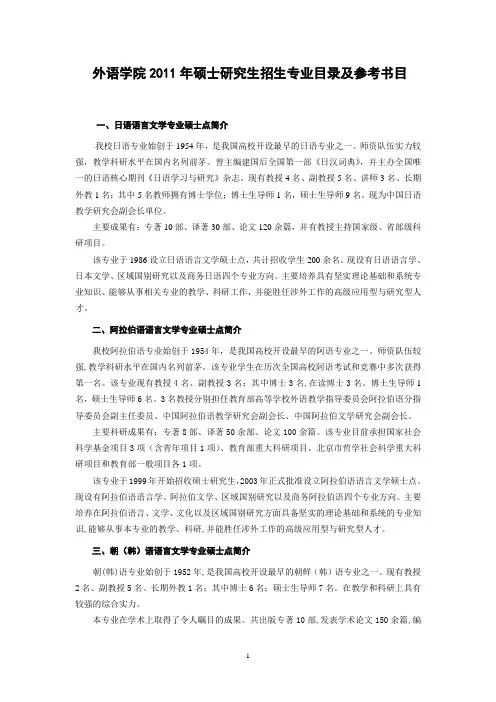
外语学院2011年硕士研究生招生专业目录及参考书目一、日语语言文学专业硕士点简介我校日语专业始创于1954年,是我国高校开设最早的日语专业之一。
师资队伍实力较强,教学科研水平在国内名列前茅。
曾主编建国后全国第一部《日汉词典》,并主办全国唯一的日语核心期刊《日语学习与研究》杂志。
现有教授4名、副教授5名、讲师3名、长期外教1名;其中5名教师拥有博士学位;博士生导师1名,硕士生导师9名。
现为中国日语教学研究会副会长单位。
主要成果有:专著10部、译著30部、论文120余篇,并有教授主持国家级、省部级科研项目。
该专业于1986设立日语语言文学硕士点,共计招收学生200余名。
现设有日语语言学、日本文学、区域国别研究以及商务日语四个专业方向。
主要培养具有坚实理论基础和系统专业知识、能够从事相关专业的教学、科研工作,并能胜任涉外工作的高级应用型与研究型人才。
二、阿拉伯语语言文学专业硕士点简介我校阿拉伯语专业始创于1954年,是我国高校开设最早的阿语专业之一。
师资队伍较强,教学科研水平在国内名列前茅。
该专业学生在历次全国高校阿语考试和竞赛中多次获得第一名。
该专业现有教授4名、副教授3名;其中博士3名,在读博士3名。
博士生导师1名,硕士生导师6名。
3名教授分别担任教育部高等学校外语教学指导委员会阿拉伯语分指导委员会副主任委员、中国阿拉伯语教学研究会副会长、中国阿拉伯文学研究会副会长。
主要科研成果有:专著8部、译著50余部、论文100余篇。
该专业目前承担国家社会科学基金项目3项(含青年项目1项)、教育部重大科研项目、北京市哲学社会科学重大科研项目和教育部一般项目各1项。
该专业于1999年开始招收硕士研究生,2003年正式批准设立阿拉伯语语言文学硕士点。
现设有阿拉伯语语言学、阿拉伯文学、区域国别研究以及商务阿拉伯语四个专业方向。
主要培养在阿拉伯语言、文学、文化以及区域国别研究方面具备坚实的理论基础和系统的专业知识,能够从事本专业的教学、科研,并能胜任涉外工作的高级应用型与研究型人才。
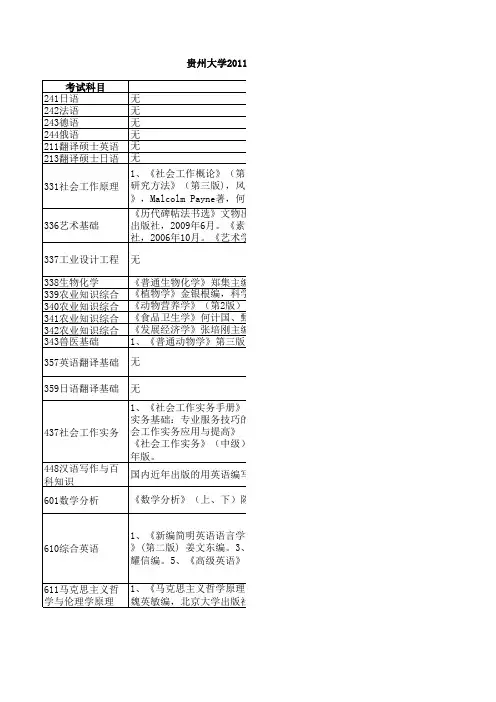
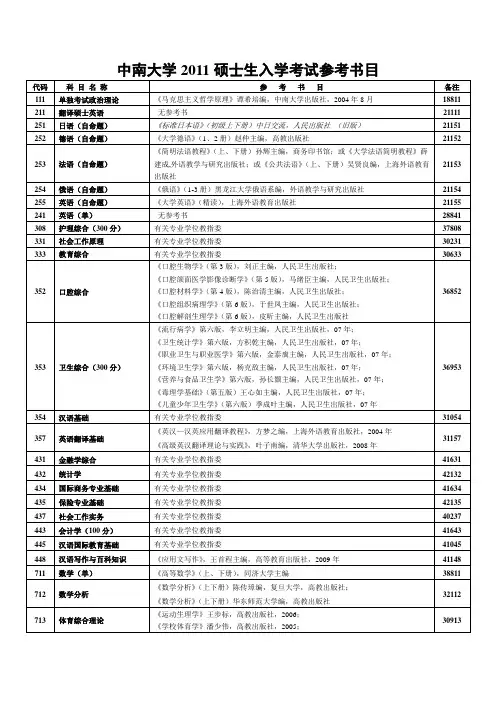
川外汉硕参考书目1. 简介川外汉硕是指成都外国语大学的汉语国际教育硕士专业。
该专业旨在为国际学生提供高质量的汉语教育,培养汉语教学、汉语研究、汉语文化传播等领域的高级人才。
近年来,川外汉硕作为学习汉语的热门专业吸引了越来越多的国际留学生的关注。
2. 川外汉硕课程川外汉硕课程主要分为汉语教学和汉语研究两大方向。
其中,汉语教学方向主要包括语音、词汇、语法、听力、口语、阅读、写作等方面的知识和教学技能。
汉语研究方向则包括汉语语言学、汉字学、汉语教育研究、汉语测试评估等方面的理论和研究方法。
此外,川外汉硕还为学生提供了丰富的实践机会,例如汉语教学实习、汉语文化体验、到中国企业实习等。
3. 川外汉硕参考书目以下是川外汉硕学生可以参考的书目:- 《现代汉语》(第三版),北京语言大学出版社;- 《HSK标准教程》(一到六级),北京语言大学出版社;- 《实用汉语语法》(第二版),商务印书馆;- 《现代汉语常用词词典》(第七版),商务印书馆;- 《汉语语音教程》(修订版),北京语言大学出版社;- 《读写汉字》(第六版),北京语言大学出版社;- 《中级汉语口语》(第三版),北京语言大学出版社;- 《中国文化常识》(修订版),北京语言大学出版社。
4. 学生建议川外汉硕的学生怎样才能更好地学习和提高汉语水平呢?以下是一些学生的建议:- 多听多说多练习。
学习语言最关键的是口语能力,因此学生应该更多地参与汉语口语课程,多与中国人交流、练习,不断提高语音、语调、语速等方面的能力。
- 多读多写。
阅读和写作是学习汉语的另外两个重要方面。
学生应该多读中国文学、报纸杂志等,扩大词汇量和语感;同时,多写作文、日记等锻炼自己的写作水平。
- 综合运用所学。
学生在学习汉语教学和汉语研究的同时,要注重将知识应用于实践中,比如参与教学实习、写论文等,让所学有用武之地。
- 多了解中国文化。
汉语教学应该与中国文化传播相结合,学生应该更多地了解中国历史、文化、社会等方面的知识,为今后的教学和研究打下更为扎实的基础。
南京师大2011年外国语学院硕士生招生目录书目 2010-09-20 Google提供的广告50 x used Reachstacker,Containerhandling machines with prices, pics and Videos (007) 外国语学院专业及方向初试科目复试科目加试科目人数040102 课程与教学论01 英语学科教学论①101思想政治理论②241日语(二外)或242俄语(二外)或243法语(二外)或244德语(二外)或245韩语(二外)或246西班牙语(二外)或247意大利语(二外)③311教育学专业基础综合④--无⑤F078英语教学综合基础(英语教学论和基础英语)⑥综合英语⑦英汉互译和写作3初试参考书目241 日语(二外):《中日交流标准日本语》(初级上下册),人教出版社(老版本)242 俄语(二外):《大学俄语基础教程》(1—4册),高教出版社243 法语(二外):《法语》(1-3册),马晓宏等著,外语教学与研究出版社;《法语基础语法》,广州外国语学院编,商务印书馆244 德语(二外):《新编大学德语》,朱建华总主编,王依主编,外语教学与研究出版社245 韩语(二外):《新基础韩国语》(上、下册),李红梅、俞成云著,北京语言大学出版社,2007年版或2008版246 西班牙语(二外):《现代西班牙语》(1-4册),董燕生著,外语教学与研究出版社,2002年版;《西班牙语实用语法新编》,孙义桢著,上海外语教育出版社,1990年版247 意大利语(二外):《大学意大利语教程》第1册,王军主编,外语教学与研究出版社;《大学意大利语教程》第2册,王军主编,外语教学与研究出版社;《大学意大利语教程》第3-4册,王军主编,外语教学与研究出版社复试参考F078 英语教学综合基础(英语教学论和基础英语):书目《外语教学与学习—理论与实践》,(英)马丁•韦德尔、(中)刘润清编著,高等教育出版社;《英语教学法教程》(第二版),王蔷主编,高等教育出版社备注专业及方向初试科目复试科目加试科目人数050108 比较文学与世界文学01 英美文学02 德国文学01方向:①101思想政治理论②241日语(二外)或242俄语(二外)或243法语(二外)或244德语(二外)或245韩语(二外)或246西班牙语(二外)或247意大利语(二外)③624翻译与外语写作④832外国语言文学基础知识与汉语写作(汉语答)02方向:①101思想政治理论②240英语(二外)或241日语(二外)或242俄语(二外)或243法语(二外)或245韩语(二外)或246西班牙语(二外)或247意大利语(二外)③624翻译与外语写作④832外国语言文学基础知识与汉语写作(汉语答)01方向:⑤F079英美文学02方向:⑤F080德国文学01方向:⑥综合英语⑦英汉互译与写作02方向:⑥综合德语⑦德汉互译6初试参考书目240 英语(二外):《大学英语》(1—4册),上海外语教育出版社241 日语(二外):《中日交流标准日本语》(初级上下册),人教出版社(老版本)242 俄语(二外):《大学俄语基础教程》(1—4册),高教出版社243 法语(二外):《法语》(1-3册),马晓宏等著,外语教学与研究出版社;《法语基础语法》,广州外国语学院编,商务印书馆244 德语(二外):《新编大学德语》,朱建华总主编,王依主编,外语教学与研究出版社245 韩语(二外):《新基础韩国语》(上、下册),李红梅、俞成云著,北京语言大学出版社,2007年版或2008版246 西班牙语(二外):《现代西班牙语》(1-4册),董燕生著,外语教学与研究出版社,2002年版;《西班牙语实用语法新编》,孙义桢著,上海外语教育出版社,1990年版247 意大利语(二外):《大学意大利语教程》第1册,王军主编,外语教学与研究出版社;《大学意大利语教程》第2册,王军主编,外语教学与研究出版社;《大学意大利语教程》第3-4册,王军主编,外语教学与研究出版社624 翻译与外语写作:水平考试,不指定参考书832 外国语言文学基础知识与汉语写作(汉语答):比较文学与世界文学:01方向:同英语语言文学专业的01、04方向02方向:《德语教程》,赵登荣、聂黎曦、梁敏,北京大学出版社;《德国文学简史》,Karl-Heinz Wuest,外语教学与研究出版社。
四川大学外国语学院2010年英语语言文学专业和外国语言学及应用语言学专业硕士研究生入学考试科目及推荐参考书一、适用专业及方向:英语语言文学:现代英美文学、美国文化研究、加拿大文化研究、欧洲文化研究外国语言学及应用语言学:现代英语及语言理论、现代外语教育及教育技术、英语翻译理论与实践二、考试科目及分值:三、各科试题结构说明:1.政治(国家统一考试,略)2.二外(略)3.基础英语(150分):●Cloze Test或改错(10分)●阅读理解(30分)●英译汉(30分)●汉译英(30分)●阅读与写作(50分)4.英语专业综合知识(150分)●英语国家社会和文化知识(50分)●英语文学知识(50分)●英语语言知识(50分)四、推荐参考书目(版本不限):基础英语、英语专业综合知识1.Beidler, Peter G. Writing Matters,四川大学出版社。
2.郭著章,李庆生:《英汉互译实用教程》(第三版),武汉大学出版社。
3.胡壮麟:《语言学教程》,北京大学出版社,2001年。
4.李宜燮,常耀信:《美国文学选读》(上、下册),南开大学出版社。
5.罗经国:《新编英国文学选读》(上、下册),北京大学出版社。
6.王佐良等:《欧洲文化入门》(第二版)(第1-4章),外语教学与研究出版社。
7.朱永涛: 《英美文化基础教程》,外语教学与研究出版社。
第二外语1.法语:《新大学法语》(1-3册),总主编李志清,高等教育出版社。
2.日语:《标准日本语》(初级),人民教育出版社。
3.德语:《德语速成》(第二版,上、下册),外语教学与研究出版社。
4.俄语:《大学俄语(东方)》(第1-3册),北京外国语大学、普希金俄语学院合编。
5.西班牙语:《现代西班牙语》(1-2册),董燕生.刘建.外研社。
6.韩语:延世大学韩国语学堂[韩] 编著:韩国语教程 1-3册(全6册),世界图书出版公司。
四川大学外国语学院英语语言文学专业和外国语言学及应用语言学专业硕士研究生入学考试复试科目及推荐参考书1一、适用专业及方向:英语语言文学:现代英美文学、美国文化研究、加拿大文化研究、欧洲文化研究外国语言学及应用语言学:现代英语及语言理论、现代外语教育及教育技术、英语翻译理论与实践二、考试科目及分值:三、各科试题说明:1.听力(20分)1复试科目、方式如届时国务院学位办以及学校有新的规定,则按学位办及学校的新规定执行。
翻译方向研究生阅读书目一、必读书目1.英文部分Nida, Eugene A. Language, Culture, and Translating. Shanghai: Shanghai Foreign Language Education Press, 1997.-------------------. Language and Culture: Contexts in Translating. Shanghai: Shanghai Foreign Language Education Press, 2001.Newmark, Peter. A Textbook of Translation. Hertfordshire: Prentice Hall International Ltd., 1988. Kelly, L. G. The True Interpreter: A History of Translation, Theory and Practice in the West.Oxford: Basil Blackwell, 1979.Munday, Jeremy. Introducing Translation Studies: Theories and Applications. London and New York: Routledge, 2001.Gentzler, Edwin. Contemporary Translation Theories. London and New York: Routledge, 1993. Chang, Lung-hsi. The Tao and the Logos: Literary Hermeneutics, East and West. Duke University Press, 1992.Venuti,.Lawrence. The Translator’s Invisibility----A History of Translation. Shanghai: Shanghai Foreign Language Education Press, 2004.Wilss, Wolfram. The Science of Translation: Problems and Methods. Shanghai: Shanghai Foreign Language Education Press, 2001.Williams, Jerry, & Andrew Chesterman. The Map: A Beginner’s Guide to Doing Research in Translation Studies. Shanghai: Shanghai Foreign Language Education Press, 2004. Bassnett, Susan. Translating Literature. Cambridge: D. S. Brewer, 1997.------------------. Translation Studies. Revised Edition. London & New York: Routledge, 1991. Bassnett, Susan, and Andre Lefevere. Constructing Cultures: Essays on Literary Translation.Shanghai: Shanghai Foreign Language Education Press, 2001.Bassnett, Susan, and Andre Lefevere. Translation, History and Culture. Shanghai: Shanghai Foreign Language Education Press, 2001.Lefevere, Andre. Translation, Rewriting and the Manipulation of Literary Fame. London & New York: Routledge, 1992.Lefevere, Andre. Translation/History/Culture. Shanghai: Shanghai Foreign Language Education Press, 2004.Katan, David. Translating Cultures: An Introduction for Translators, Interpreters and Mediators.Shanghai: Shanghai Foreign Language Education Press, 2004.Toury, Gideon. Descriptive Translation Studies and Beyond. Shanghai: Shanghai Foreign Language Education Press, 2001.Hermans, Theo. Translation in Systems: Descriptive and System-oriented Approaches Explained.Shanghai: Shanghai Foreign Language Education Press, 2004.-----------------. The Manipulation of Literature: Studies in Literary Translation. London & New York: Croom Helm, 1985.Gutt, Ernst-August. Translation and Relevance: Cognition and Context.Shuttleworth, Mark, & Moira Cowie. Dictionary of Translation Studies. Shanghai: Shanghai Foreign Language Education Press, 2004.Hatim, Basil. Communication Across Cultures: Translation Theory and Contrastive Text Linguistics. Shanghai: Shanghai Foreign Language Education Press, 2001.Snell-Hornby, Mary. Translation Studies----An Integrated Approach. Shanghai: Shanghai Foreign Language Education Press, 2001.Tymoczko, Maria. Translation in a Postcolonial Context: Early Irish Literature in English Translation. Shanghai: Shanghai Foreign Language Education Press, 2004.Reiss, Katharina. Translation Criticism: The Potentials & Limitations. Shanghai: Shanghai Foreign Language Education Press, 2004.Flotow, Luise von. Translation and Gender: Translating in the ‘Era of Feminism’. Shanghai: Shanghai Foreign Language Education Press, 2004.Davis, Kathleen. Deconstruction and Translation. Shanghai: Shanghai Foreign Language Education Press, 2004.Nord, Christiane. Translating as a Purposeful Activity: Functionalist Approaches Explained.Manchester: St. Jerome Publishing, 1997.Robinson, Douglas. What Is Translation?: Centrifugal Theories, Critical Interventions. Kent: The Kent State University Press, 1997.----------------------. Translation and Empire: Postcolonial Theories Explained. Manchester: St.Jerome Publishing, 1997.Venuti, Laurence. The Scandals of Translation: Towards an Ethics of Difference. London and New York: Routledge, 1998.Rose, Marilyn Gaddis. Translation and Literary Criticism. Manchester: St. Jerome Publishing, 1997.Pym, Anthony. Method in Translation History. Manchester: St. Jerome Publishing, 1998. Baker, Mona. Routledge Encyclopedia of Translation Studies. London & New York: Routledge, 1998.Frawley, William, ed. Translation: Literary, Linguistic, and Philosophical Perspectives. Newark: University of Delaware Press, 1984.Steiner, George. After Babel: Aspects of Language and Translation. Shanghai: Shanghai Foreign Language Education Press, 2001.Sakai, Naoki. Translation and Subjectivity. Minneapolis: University of Minnesota Press, 1997. Bowie, Andrew. Aesthetics and Subjectivity: from Kant to Nietzsche. Manchester and New York: Manchester University Press, 1990.Robinson, Douglas. Western Translation Theory: from Herodotus to Nietzsche. Manchester: St.Jerome Publishing, 1997.2.中文部分:郭建中编著,《当代美国翻译理论》,武汉:湖北教育出版社,2000年。
2011年硕士研究生招生考试(初、复试)参考书目各专业共同考试科目:101思想政治理论:全国统考试题外国语(含第二外语):201英语一、202俄语、203日语由国家统一命题,241英语、242俄语、243日语、244德语、245法语、246西班牙语由我校自行命题自命题参考书目:1. 241英语:任选一套大学本科外语专业学生所用英语二外教材2. 242俄语:大学俄语《东方》(1-3册),丁树杞主编,外语教学与研究出版社3. 243日语:《大学日本语》(1-3册),王廷凯主编,四川大学出版社4. 244德语:《德语》,吴永年、华宗德编著,上海外语教育出版社5. 245法语:《法语》(1-3册),北京外国语大学法语系马晓宏编著,外语教学与研究出版社或《简明法语教程》(上、下册),孙辉编著,商务印书馆(任选其中一套)6. 246西班牙语:《现代西班牙语》(1-2册),刘元祺、徐蕾编,外语教学与研究出版社或《西班牙语速成》(上下册),李威伦编,北京语言文化大学出版社010103外国哲学专业:初试参考书目:1. 631哲学综合1) 《哲学通论》,孙正聿,复旦大学出版社2) 《中国哲学史》(上、下),冯友兰,华东师范大学出版社2. 831西方哲学史,1) 《西方哲学简史》,赵敦华,北京大学出版社2) 《政治哲学导论》,托马斯,中国人民大学出版社复试参考书目:《新编现代西方哲学》,刘放桐主编,人民出版社040102课程与教学论专业:初试参考书目:311教育学专业基础综合由教育部统一命题复试参考书目:《课程理论》,施良方,教育科学出版社《中国教育史》(修订版),孙培青,华东师范大学出版社《外国教育史》(修订本),王天一等,北京师范大学出版社050101文艺学专业:初试参考书目:1. 622文艺学综合1)《文学理论教程》,童庆炳主编,高等教育出版社(01、02、03方向)2)《认识媒介文化》,尼克·史蒂文森著,商务印书馆(03方向)3)《传媒·文化·社会》,吴飞、王学成著,山东人民出版社(03方向)2. 822西方文艺学1)《西方文论史》(修订版),马新国主编,高等教育出版社(01、02、03方向)2)《新闻理论教程》,杨保军著,中国人民大学出版社(03方向)3)《传播学概论》,郭庆光著,中国人民大学出版社(03方向)复试参考书目:01文艺美学与视觉文化方向:《文化研究导论》,陆扬、王毅,复旦大学出版社02影视文艺学方向:《西方电影艺术史略》,张专,中国广播电视出版社03文化与传媒方向:《新闻写作学》、《新闻采访学》、《新闻编辑学》、《新闻评论学》(国内统编教材均可)050103汉语言文字学专业:初试参考书目:1. 623现代汉语与语言学概论1) 《现代汉语》,黄伯荣、廖序东主编,高等教育出版社2) 《语言学纲要》,叶蜚声、徐通锵著,北京大学出版社2. 823古代汉语1) 《古代汉语》,郭锡良等编,商务印书馆复试参考书目:《语法讲义》,朱德熙,商务印书馆《现代汉语语法研究教程》,陆俭明,北京大学出版社050106中国现当代文学专业:初试参考书目:1. 624文学综合1) 《中国文学》(四卷本),袁行霈主编,高等教育出版社2) 《外国文学史》,郑克鲁主编,高等教育出版社3) 《文学理论教程》,童庆炳主编,高等教育出版社2. 824中国现当代文学1) 《中国现代文学三十年》,钱理群、温儒敏、吴福辉著,北京大学出版社2) 《中国当代文学史》,洪子诚著,北京大学出版社3) 《中国当代文学史教程》,陈思和主编,复旦大学出版社复试参考书目:《中国现代文学三十年》,钱理群、温儒敏、吴福辉著,北京大学出版社《比较文学教程》,曹顺庆主编,高等教育出版社《文学理论教程》,童庆炳主编,高等教育出版社050108比较文学与世界文学专业:初试参考书目:1. 621中国文学:1) 《中国文学史》(上、中、下)章培恒等编,复旦大学出版社2) 《中国现代文学三十年》钱理群、温儒敏、吴福辉著,北京大学出版社2. 821欧美文学:《外国文学史》(第三版)朱维之、赵澧、崔宝衡编,南开大学出版社复试参考书目:《比较文学》,陈惇、刘象愚、谢天振等主编,高等教育出版社050201英语一语言文学专业:初试参考书目:1. 611基础英语(主要检测英语阅读理解能力):1) 高校英语专业现行“精读”类课程高年级教材(任选)2. 811翻译与写作:1) 《英汉互译实用翻译教程》,冯庆华编著,上海外语教育出版社或其他高等院校专业英语英汉互译教材。
2) 《英语写作手册》,丁往道等编著,北京外语教学与研究出版社复试参考书目:01英语语言理论与实践方向:《语言学教程》(英文修订版),胡壮麟主编,北京大学出版社《语言学教程》(中文版),胡壮麟主编,北京大学出版社02英语文学方向:英语专业本科英美文学史及选读教材03翻译理论与实践方向:EugeneA. Nida. 2001. Language and Culture: Context in Translating.语言与文化——翻译中的语境,上海外语教育出版社04主要英语国家社会文化方向:英语专业本科任选一套英语国家概况教材中的英、美、加部分。
05英语教学理论与实践方向:Richards, J.C. and Rodgers, T.S., Approaches and Methods in Language Teaching. Oxford University Press.(外语教学与研究出版社)Ellis, Rod, Second Language Acquisition. Oxford University Press.(上海外语教育出版社)《现代外语教学》,束定芳、庄智象,上外教育出版社050202俄语语言文学专业:初试参考书目:1.612基础俄语《东方·大学俄语》(1-8册)北外与普院合编,外语教学与研究出版社2. 812翻译与写作(俄)《俄汉、汉俄翻译理论与技巧》(修订本),程荣辂编,电子工业出版社复试参考书目:俄语综合1)《Coвременный pyccкийязык》Д.З.Розенталь, M.19842)《现代俄语理论教程》,王超尘等,上海外语教育出版社3)《俄罗斯文学史》,任光宣著,北京大学出版社4)《俄语修辞学》,吕凡主编,外语教学与研究出版社5)《俄语语言国情学》(修订本),谭林主编,吉林大学出版社6)《俄罗斯历史之路——千年回眸》,李英男等,外语教学与研究出版社050203法语语言文学专业:初试参考书目:1.613基础法语:1)《法语》(1-4册),马晓宏等编著,外语教学与研究出版社2)《法语阅读课本》,王文融主编,北京大学出版社3)《Le Nouveau sans Frontières》(1-3册),CLE INTERNATIONAL.1)《法汉翻译教程》,陈宗宝编著,上海译文出版社2)《汉译法实践》,岳扬列编著,上海译文出版社3)《法语写作:技法与实战》,陈伟、[法]奥迪尔·尚特劳夫编,上海译文出版社复试参考书目:法语综合1)《法语国家与地区概况》,丁雪英等编著,外语教学与研究出版社2)《法语语言学教程》,王秀丽编著,外语教学与研究出版社3)《法国文学作品选读》(上下册),赵俊欣主编,上海译文出版社4)《法国文学导读》,徐真华主编,上海外语教育出版社5)《Histoire de la Civilisation et de la Littérature Françaises》,Dominnique Maitrot, Isabelle Rabut, Société des Editions cul turelles internationales.050204德语语言文学专业:初试参考书目:1. 614基础德语1)《高级德语教程》(三年级用),陈晓春编著,上海外语教育出版社2)《大学德语教程》(四年级用),蔡幼生编著,上海外语教育出版社3)《文学与认识》,王炳钧编著,外语教育与研究出版社2. 814翻译与写作(德)1)《德汉翻译教程》(德汉互译),张崇智,外语教学与研究出版社2)《汉德翻译教程》,桂乾元,肖培生编,上海译文出版社3)《德语写作教程》,倪仁福编,南京大学出版社复试参考书目:德语综合1)《文学与认识》,王炳钧,外语教学与研究出版社2)《德国文化史》,李伯杰,北京经贸大学出版社3) Baumann, Barbara und Oberle, Birgitta: Deutsche Literatur in Epochen. 2.überarbeitete Auflage. Donauwrth: Max Huber.4) Werner Koller, Einführung in die Übersetzungswissenschaft. Wiebelsheim: Q uelle & MeyerVerlag050205日语语言文学专业:初试参考书目:1. 615基础日语《日语》(5-8册)上海外国语大学日语精读教材,上海外语教育出版社《日汉互译教程》,高宁编著,南开大学出版社复试参考书目:日语综合1) 《日语文语语法》,王廷凯主编,四川大学出版社2) 《日本文学史》,西乡信纲著,佩珊译,人民文学出版社3) 《日本国家概况》,刘笑明编著,南开大学出版社050210亚非语言文学(朝鲜语方向):初试参考书目:大学本科朝鲜语专业高年级教材均可复试参考书目:1.《韩国文学论纲》,赵东一编者,北京大学出版社,2003年。
(中文)2.《现代国语通史论》,南基心,太学社,2001年。
(韩文)3.《韩国现代文化》,李善伊,韩国文化社,2007年。
(韩文)4.《韩国文学讲义》,赵东一,道友社(길벗),1998。
(韩文)5.《韩国文学史》,金允植,民音社,1998。
(韩文)6.《国语学概说》,李基文,太学社,2006。
(韩文)050211外国语言学及应用语言学:初试参考书目:1. 611基础英语高校英语专业现行“精读”类课程高年级教材(任选)2. 811翻译与写作1) 《英汉互译实用翻译教程》,冯庆华编著,上海外语教育出版社或其他高等院校专业英语英汉互译教材。
2) 《英语写作手册》,丁往道等编著,北京外语教学与研究出版社复试参考书目:《语言学教程》(英文修订版),胡壮麟主编,北京大学出版社《语言学教程》(中文版),胡壮麟主编,北京大学出版社055201英语笔译055202英语口译:初试参考书目:1. 211翻译硕士英语高校英语专业现行“精读”类课程高年级教材(任选)2. 351英语翻译基础1) 《英汉翻译简明教程》,庄绎传编著,外语教学与研究出版社2) 《高级翻译十二讲》,杨全红编著,武汉大学出版社3. 451汉语写作与百科知识1) 《中国文化概论》,张岱年、方克立主编,北京师范大学出版社2) 《中国文学史》,袁行霈主编,高等教育出版社复试参考书目:055201英语笔译:《英汉翻译简明教程》,庄绎传编著,外语教学与研究出版社《高级翻译十二讲》,杨全红编著,武汉大学出版社055202英语口译:《实用口译教程新编——理论技巧与实践》,李芳琴等编著,四川人民出版社。